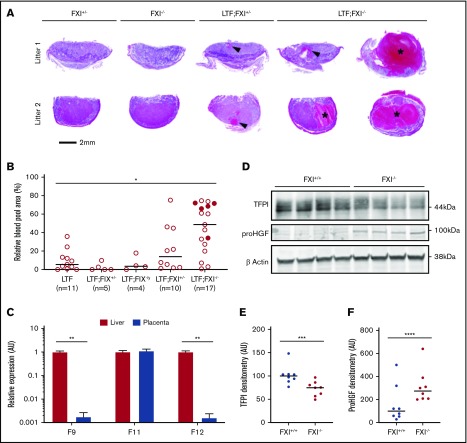Figure 4.
Analysis of the contribution of FIX and FXI to placental blood pooling under conditions of low TF. (A) Representative images of placentas from 2 dams from breeding 3 (top row) and 4 (bottom row), each showing a large blood pool in a low-TF;FXI−/− placenta. Genotypes have been abbreviated to FXI+/− (mTF+/−;hTF+/(+/−);FXI+/−), FXI−/− (mTF+/+;hTF+/(+/−);FXI−/−), low TF;FXI+/− (mTF−/−;hTF+/(+/−);FXI+/−), and low TF;FXI−/− (mTF−/−;hTF+/(+/−);FXI−/−). Blood pools are indicated by arrowheads or asterisks in placentas of E14.5 sections stained with hematoxylin and eosin. (B) The percentage of placental area occupied by maternal blood pools in placentas of different genotypes was quantified at E13.5-E15.5 (n = 4-17 per group). Filled circles indicate ruptured placentas. A significant increase in the percentage area occupied by blood pools was observed in low-TF;FXI−/− placentas compared with low-TF;FXI+/+ placentas. *P < .01, Kruskal-Wallis with post hoc Dunn’s tests; low TF;FIX+/y;FXI+/+ (LTF) vs low TF;FXI−/−. Data represented as individual values with median. (C) F9, F11, and F12 gene expression in the placenta at E14.5 was assessed by quantitative polymerase chain reaction and expressed relative to expression of these genes in the liver. Data are the mean ± SD. **P < .0001 unpaired Student t test (liver vs placenta). (D) Representative western blots of TFPI, pro-HGF, and β-actin in tissue lysates from FXI+/+ and FXI−/− placentas. Densitometric analysis of TFPI (E) and pro-HGF (F) in FXI−/− placentas and FXI+/+ controls (n = 8 per group) normalized against β actin expression. Data are presented as individual values with the median. ***P < .01; ****P < .05, Mann-Whitney U test.

